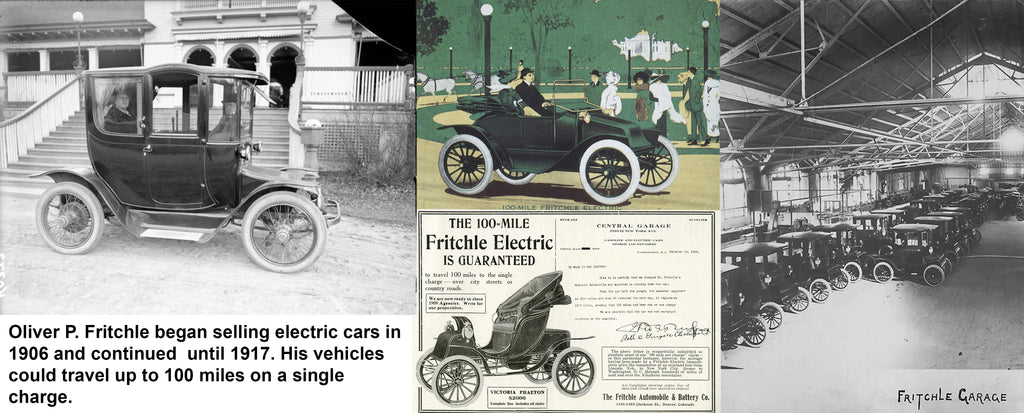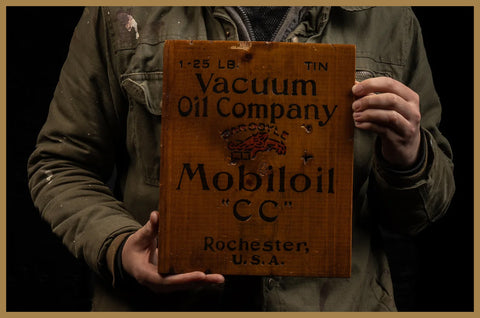Beacon Oil was a gas and oil refining and distribution company started in 1919 by the Massachusetts Gas Companies, a trust that voluntarily formed in 1902 after a series of foreclosures in the New England area. Beacon Oil was a company that grew exceedingly fast, and broke a lot of things in the process - mostly in their hometown headquarters of Everett, Massachusetts. Beacon acquired many other gas and oil interests including Pennzoil and Dixie Oil, and local gasoline stations under the name Colonial Gas. After a 1928 explosion, the company was lead by Standard Oil who kept the brand alive until the 1950s. Let's check out some history.
THE ELECTRIC THREAT
To understand the tumultuous existence of Beacon Oil, we need to go back to New England in the 1890s. Because of a series of financial problems, gas and oil companies couldn't pay their bills. The popularity of electricity was eating into the oil industry in a big way. Scottish inventor Robert Anderson created the first crude electric car in the 1830s. Wabash, Indiana is credited for having the first electric street lights in 1880. Hydropower plants in Grand Rapids, Michigan, Ottawa, Ontario, Dolgeville, New York, and Niagara Falls, New York all came online in a 2 year span of 1880-1881 powering mills and local areas. In the 1890s, William Morrison of Des Moines, Iowa creates the first successful electric vehicle in the U.S. Even though electric trolleys were replacing horse-drawn trams in Europe since the 1881, Frank Sprague installed a complete system of electric streetcars in Richmond, Virginia in 1888. Mexico City installed it’s battery-powered tram in 1896.
Coming up on the 1900s, the gas and oil industry was trying its best to maintain relevancy, and with that need for adaptation came some large-scale financial blunders. Old Colony Trust Company of Boston, Massachusetts was an investment company that partnered with Colonial Trust of New York. Both trust companies held shares in each other, and both invested heavily in railroads, mining, gas, oil, coal, banks and other trusts. Having control of every aspect of oil production, refining, transportation, and distribution means that a lot could get done quickly without a lot of red tape, with the potential of reestablishing oil as the dominate energy source for Americans.
BUSINESS AS USUAL
The "big tent" investment Trust business model came with some shady exchanges. For example, in 1906 American Loan and Trust was acquired by Old Colony Trust when some of the active shareholders of American Loan died and left their holdings to their individual estates. According to the April 24, 1906 Wall Street Journal (page 8), Old Colony bought those shares directly from those estates for $350 each, 68 points above the book value and 71 points above the last public sell. This was quite a comfort to a family grieving the loss of their patriarch. Old Colony continued to expand and according to the February 21, 1910 New York Times (page 15) Old Colony Trust took over Boston’s City Trust with a capital of $2,500,000 and a surplus of $10,000,000 with an expected deposit collection of $70,000,000 (or $2.27 billion today). Obviously, there was a lot of money that could be used investing in gas and oil interests even while electricity was taking over the news after the dazzling electric spectacle of Chicago’s 1893 Columbian Expedition World’s Fair. Also in this time was the a world-wide feud between Thomas Edison and Nicola Tesla (Edison killed Topsy the Elephant in 1903), and electric vehicles enjoying their heyday in public transportation and personal mobility.
One way to combat this growing threat was to consolidate all the parts, and create a streamlined process to extract crude oil, refine it, transport it, and distribute it to the end user in custom made gas stations. Old Colony Trust Company of Boston and Colonial Trust of New York eventually had all the parts they needed to create such a system. Working with Massachusetts Gas Companies that formed in 1902, Old Colony Trust & Friends created Beacon Oil in Everett, Massachusetts. As combustible engine cars became larger, more luxurious, and SAFER, more drivers meant more gas and oil sales, and Beacon'S Colonial Gas Stations were built to be iconic, exciting, and efficient. Colonial stations operated or licensed 350 gas stations before acquiring Kesbec chain of gas stations that took the total up to 405.
EXPLOSIVE GROWTH
But all that growth in under 10 years came at a cost, especially for the local residents of Everett. Land acquisitions, railroad expansions, increased production, and larger holding tanks were all fast tracked and approved without public concerns or input, and sometimes without public knowledge. Beacon’s fast expansion and lack of attention to details lead to many accidents that increased local animosity. On April 14, 1922, an explosion at the Everett refinery injured four and killed Harry Vokes, a retired vaudeville performer. A hundred and fifty one residents of Everett filed a bill with the Massachusetts Supreme Court to shut down the plant, but the bill was dismissed in court. A fire on March 10, 1925 required the evacuation of 200 locals. On December 10, 1926 another explosion shook Everett, Winchester, and Medford recking buildings and injuring a policeman. The “big one” came on February 10, 1928 when 10 stills ignited 500,000 gallons of oil, killing 14 employees and destroyed many of the nearby neighborhoods. On July 22, 1929 another explosion injured 2 employees.
Email Subscribers: Use code NF3D for 20% off this weeks select wares!
By 1930, Standard Oil Company acquired Beacon Oil, and rebranded it as Colonial Beacon. With better operations came a better time for Beacon, though not quite enough to garner the forgiveness of the locals. Even in working on this blog, it seems like Everett, Massachusetts barely even want to admit Beacon Oil even existed... and who could blame them? In 1947, Standard Oil took over the assets of Colonial Beacon and continued the brand until the 1950s. As for the citizens of Everett, the refinery was finally closed in 1965 for being “unprofitable.” Now, let’s get to the contentious part… the signage.
HOW MUCH ARE BEACON SIGNS WORTH?
Beacon signs come in 2 categories: The Massachusetts-based Beacon Oil, which we covered here in this blog, and the Los Angeles-based Beacon Gasoline, a product of The Caminol Company starting in 1931 that tried to capitalize on the east coast Beacon popularity. Unfortunately, both are widely reproduced. For those in antiques, this is the mental division between someone who asked about a sign they bought versus a sign they found.
Signs from Beacon Oil that are between 1922 and 1929 are before the Standard Oil acquisition. Today, small Beacon Gas porcelain pump signs bring in a consistent $600-900. The round green Beacon Oil signs start over $2,000 depending on the size and condition, but increase in value rather quickly. Signs that have “Colonial Beacon” would be from the 1930-40s. The green sign with white stripes and white lettering would come after Beacon’s acquisition of gas, oil, and kerosene producer Pennzoil. As pointed out by THIS blog, anything with Ethyl would’ve come after 1923.
Not to be confused with Beacon Oil are Beacon Gasoline signs from the 1930s. They are one of the strange cases where the copycat out-sells the original, and with brighter, more engaging colors and the radiant lighthouse imagery, it's not hard to see why. The Caminol Oil Company (1932-1967) is more difficult to research, and California's oil history is wrought with confusion, but hopefully we'll have more information to share about them in a future post.
Beacon Gasoline's larger porcelain signs currently fall under the “name your price” scenario, staying consistently over tens of thousands of dollars. The prices tend to increased due to their rarity and the inability for those who own them to be willing to sell them. As with everything else, this is an early 2024 perspective, and is subject to change. If you find an original Beacon Gasoline "A Caminol Product" Ethyl sign that comes from the 1930s featuring the radiating lighthouse, and would like authentication, feel free to EMAIL US with pics.
When shopping, there are a lot of fakes and reproductions. A few sellers will try to slide their deception past unsuspecting buyers by using confusing phrases like "vintage," "old," or "old style", and other decorative descriptions. More scrupulous sellers will be accurate with the word "reproduction" and antique dealers should put dates on their items.











Leave a comment